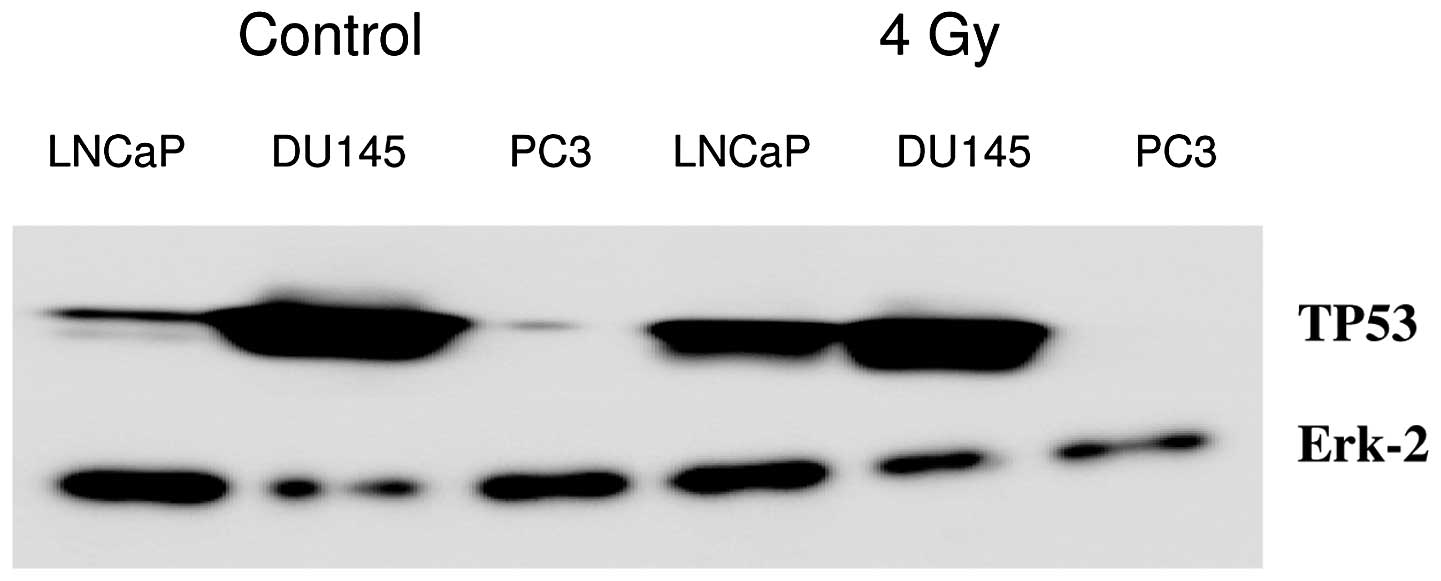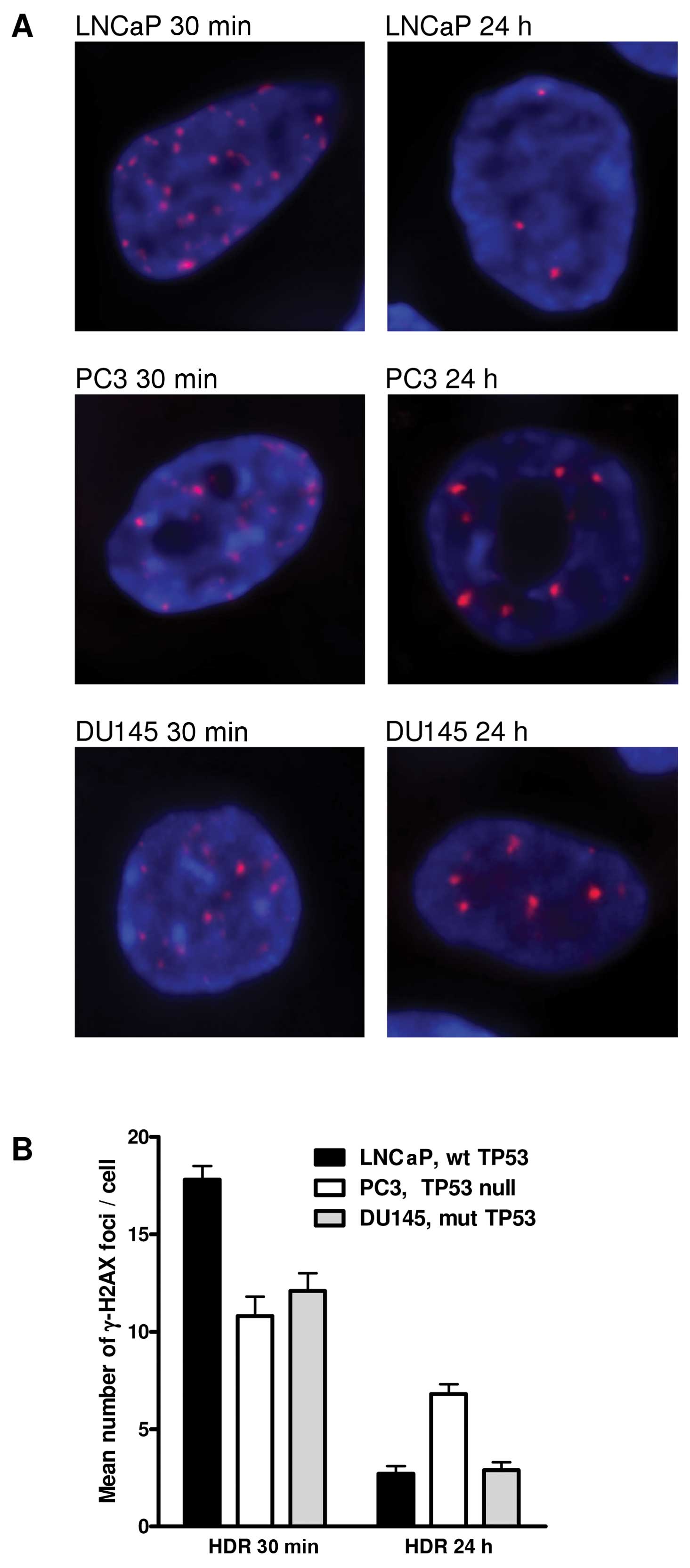|
1
|
Frankenberg-Schwager M: Induction, repair
and biological relevance of radiation-induced DNA lesions in
eukaryotic cells. Radiat Environ Biophys. 29:273–292. 1990.
View Article : Google Scholar : PubMed/NCBI
|
|
2
|
Aten JA, Stap J, Krawczyk PM, van Oven CH,
Hoebe RA, Essers J and Kanaar R: Dynamics of DNA double-strand
breaks revealed by clustering of damaged chromosome domains.
Science. 303:92–95. 2004. View Article : Google Scholar : PubMed/NCBI
|
|
3
|
Lau P, Baumstark-Khan C, Hellweg CE and
Reitz G: X-irradiation-induced cell cycle delay and DNA
double-strand breaks in the murine osteoblastic cell line OCT-1.
Radiat Environ Biophys. 49:271–280. 2010. View Article : Google Scholar : PubMed/NCBI
|
|
4
|
Beels L, Werbrouck J and Thierens H: Dose
response and repair kinetics of gamma-H2AX foci induced by in vitro
irradiation of whole blood and T-lymphocytes with X- and
gamma-radiation. Int J Radiat Biol. 86:760–768. 2010. View Article : Google Scholar : PubMed/NCBI
|
|
5
|
Vandersickel V, Depuydt J, Van Bockstaele
B, Perletti G, Philippe J, Thierens H and Vral A: Early increase of
radiation-induced γH2AX foci in a human Ku70/80 knockdown cell line
characterized by an enhanced radiosensitivity. J Radiat Res.
51:633–641. 2010.
|
|
6
|
Mosconi M, Giesen U, Langner F, Mielke C,
Dalla Rosa I and Dirks WG: 53BP1 and MDC1 foci formation in HT-1080
cells for low- and high-LET microbeam irradiations. Radiat Environ
Biophys. 50:345–352. 2011. View Article : Google Scholar : PubMed/NCBI
|
|
7
|
Zlobinskaya O, Dollinger G, Michalski D,
Hable V, Greubel C, Du G, Multhoff G, Röper B, Molls M and Schmid
TE: Induction and repair of DNA double-strand breaks assessed by
gamma-H2AX foci after irradiation with pulsed or continuous proton
beams. Radiat Environ Biophys. 51:23–32. 2012. View Article : Google Scholar : PubMed/NCBI
|
|
8
|
Olive PL and Banáth JP: Phosphorylation of
histone H2AX as a measure of radiosensitivity. Int J Radiat Oncol
Biol Phys. 58:331–335. 2004. View Article : Google Scholar : PubMed/NCBI
|
|
9
|
Hall EJ and Garcia AJ: Radiobiology for
the Radiologist. 6th edition. Lippincott Williams & Wilkins;
Philadelphia, PA: 2006
|
|
10
|
Franken NA, van Bree C, Kipp JB and
Barendsen GW: Modification of potentially lethal damage in
irradiated Chinese hamster V79 cells after incorporation of
halogenated pyrimidines. Int J Radiat Biol. 72:101–109. 1997.
View Article : Google Scholar : PubMed/NCBI
|
|
11
|
Franken N, van Bree C, Streefkerk J, Kuper
I, Rodermond H, Kipp J and Barendsen G: Radiosensitization by
iodo-deoxyuridine in cultured SW-1573 human lung tumor cells. Oncol
Rep. 4:1073–1076. 1997.PubMed/NCBI
|
|
12
|
Franken NA, Ruurs P, Ludwików G, van Bree
C, Kipp JB, Darroudi F and Barendsen GW: Correlation between cell
reproductive death and chromosome aberrations assessed by FISH for
low and high doses of radiation and sensitization by
iodo-deoxyuridine in human SW-1573 cells. Int J Radiat Biol.
75:293–299. 1999. View Article : Google Scholar : PubMed/NCBI
|
|
13
|
Franken NA, van Bree C, Veltmaat MA,
Ludwików G, Kipp JB and Barendsen GW: Increased chromosome exchange
frequencies in iodo-doxyuridine-sensitized human SW-1573 cells
after γ-irradiation. Oncol Rep. 6:59–63. 1999.PubMed/NCBI
|
|
14
|
Schwartz JL, Jordan R, Kaufmann WK, Rasey
J, Russell KJ and Weichselbaum RR: Evidence for the expression of
radiation-induced potentially lethal damage being a p53-dependent
process. Int J Radiat Biol. 76:1037–1043. 2000. View Article : Google Scholar : PubMed/NCBI
|
|
15
|
Schwartz JL, Rasey J, Wiens L, Jordan R
and Russell KJ: Functional inactivation of p53 by HPV-E6
transformation is associated with a reduced expression of
radiation-induced potentially lethal damage. Int J Radiat Biol.
75:285–291. 1999. View Article : Google Scholar : PubMed/NCBI
|
|
16
|
Franken NA, van Bree C, ten Cate R, van
Oven CH and Haveman J: Importance of TP53 and RB in the repair of
potentially lethal damage and induction of color junctions after
exposure to ionizing radiation. Radiat Res. 158:707–714. 2002.
View Article : Google Scholar : PubMed/NCBI
|
|
17
|
Franken NA, van Bree C and Haveman J:
Differential response to radiation of TP53-inactivated cells by
overexpression of dominant-negative mutant TP53 or HPVE6. Radiat
Res. 161:504–510. 2004. View
Article : Google Scholar : PubMed/NCBI
|
|
18
|
Devlin HL, Mack PC, Burich RA, Gumerlock
PH, Kung HJ, Mudryj M and deVere White RW: Impairment of the DNA
repair and growth arrest pathways by p53R2 silencing enhances DNA
damage-induced apoptosis in a p53-dependent manner in prostate
cancer cells. Mol Cancer Res. 6:808–818. 2008. View Article : Google Scholar : PubMed/NCBI
|
|
19
|
Danielsen T, Smith-Sørensen B, Grønlund
HA, Hvidsten M, Børresen-Dale AL and Rofstad EK: No association
between radiosensitivity and TP53 status, G1 arrest or protein
levels of p53, myc, ras or raf in human melanoma lines. Int J
Radiat Biol. 75:1149–1160. 1999. View Article : Google Scholar : PubMed/NCBI
|
|
20
|
van Bree C, Savonije JH, Franken NA,
Haveman J and Bakker PJ: The effect of p53-function on the
sensitivity to paclitaxel with or without hyperthermia in human
colorectal carcinoma cells. Int J Oncol. 16:739–744.
2000.PubMed/NCBI
|
|
21
|
van Bree C, Franken NA, Rodermond HM,
Stalpers LJ and Haveman J: Repair of potentially lethal damage does
not depend on functional TP53 in human glioblastoma cells. Radiat
Res. 161:511–516. 2004.
|
|
22
|
Barendsen GW: Dose fractionation, dose
rate and iso-effect relationships for normal tissue responses
(review). Int J Radiat Oncol Biol Phys. 8:1981–1997. 1982.
View Article : Google Scholar : PubMed/NCBI
|
|
23
|
Barendsen GW: RBE-LET relationships for
different types of lethal radiation damage in mammalian cells:
comparison with DNA dsb and an interpretation of differences in
radiosensitivity. Int J Radiat Biol. 66:433–436. 1994. View Article : Google Scholar : PubMed/NCBI
|
|
24
|
Barendsen GW: Parameters of
linear-quadratic radiation dose-effect relationships: dependence on
LET and mechanisms of reproductive cell death. Int J Radiat Biol.
71:649–655. 1997. View Article : Google Scholar : PubMed/NCBI
|
|
25
|
Barendsen GW: Sublethal damage and DNA
double strand breaks have similar RBE-LET relationships: evidence
and implications. Int J Radiat Biol. 63:325–330. 1993. View Article : Google Scholar : PubMed/NCBI
|
|
26
|
Barendsen GW: The relationships between
RBE and LET for different types of lethal damage in mammalian
cells: biophysical and molecular mechanisms (review). Radiat Res.
139:257–270. 1994. View
Article : Google Scholar : PubMed/NCBI
|
|
27
|
Barendsen GW, van Bree C and Franken NA:
Importance of cell proliferative state and potentially lethal
damage repair on radiation effectiveness: Implications for combined
tumor treatments (Review). Int J Oncol. 19:247–256. 2001.PubMed/NCBI
|
|
28
|
Franken NA, Hovingh S, Rodermond H,
Stalpers L, Barendsen GW and Crezee J: Radiosensitization with
chemotherapeutic agents and hyperthermia: Effects on the
linear-quadratic parameters of radiation cell survival curves. J
Cancer Sci Ther S. 5:002 View Article : Google Scholar : 2011.
|
|
29
|
Franken NA, Hovingh S, Oei A, Cobussen P,
Bergs JW, van Bree C, Rodermond HM, Stalpers LJ, Kok P, Barendsen
GW and Crezee J: Radiosensitization with hyperthermia and
chemotherapeutic agents: Effects on linear-quadratic parameters of
radiation cell survival curves (Review). Ionizing Radiation/Book 1.
Mitsuru N. Intech Publisher; 2012
|
|
30
|
van Bree C, Franken NA, Bakker PJ,
Klomp-Tukker LJ, Barendsen GW and Kipp JB: Hyperthermia and
incorporation of halogenated pyrimidines: radiosensitization in
cultured rodent and human tumor cells. Int J Radiat Oncol Biol
Phys. 39:489–496. 1997.PubMed/NCBI
|
|
31
|
Yoshikawa T, Kashino G, Ono K and Watanabe
M: Phosphorylated H2AX foci in tumor cells have no correlation with
their radiation sensitivities. J Radiat Res. 50:151–160. 2009.
View Article : Google Scholar : PubMed/NCBI
|
|
32
|
Dikomey E and Brammer I: Relationship
between cellular radiosensitivity and non-repaired double-strand
breaks studied for different growth states, dose rates and plating
conditions in a normal human fibroblast line. Int J Radiat Biol.
76:773–781. 2000. View Article : Google Scholar
|
|
33
|
Banáth JP, Klokov D, MacPhail SH, Banuelos
CA and Olive PL: Residual gammaH2AX foci as an indication of lethal
DNA lesions. BMC Cancer. 10:42010.PubMed/NCBI
|
|
34
|
Klokov D, MacPhail SM, Banáth JP, Byrne JP
and Olive PL: Phosphorylated histone H2AX in relation to cell
survival in tumor cells and xenografts exposed to single and
fractionated doses of X-rays. Radiother Oncol. 80:223–229. 2006.
View Article : Google Scholar : PubMed/NCBI
|
|
35
|
DeWeese TL, Shipman JM, Dillehay LE and
Nelson WG: Sensitivity of human prostatic carcinoma cell lines to
low dose rate radiation exposure. J Urol. 159:591–598. 1998.
View Article : Google Scholar : PubMed/NCBI
|
|
36
|
Geldof AA and Slotman BJ: Radiosensitizing
effect of cisplatin in prostate cancer cell lines. Cancer Lett.
101:233–239. 1996. View Article : Google Scholar : PubMed/NCBI
|
|
37
|
Geldof AA, Plaizier MA, Duivenvoorden I,
Ringelberg M, Versteegh RT, Newling DW and Teule GJ: Cell cycle
perturbations and radiosensitization effects in a human prostate
cancer cell line. J Cancer Res Clin Oncol. 129:175–182.
2003.PubMed/NCBI
|
|
38
|
Franken NAP, Rodermond HM, Stap J, Haveman
J and van Bree C: Clonogenic assay of cells in vitro. Nat Protoc.
1:2315–2319. 2006. View Article : Google Scholar
|
|
39
|
Bergs JW, Franken NA, ten Cate R, van Bree
C and Haveman J: Effects of cisplatin and gamma-irradiation on cell
survival, the induction of chromosomal aberrations and apoptosis in
SW-1573 cells. Mutat Res. 594:148–154. 2006. View Article : Google Scholar : PubMed/NCBI
|
|
40
|
Franken NA, van Bree C, Veltmaat MA,
Rodermond HM, Haveman J and Barendsen GW: Radiosensitization by
bromodeoxyuridine and hyperthermia: analysis of linear and
quadratic parameters of radiation survival curves of two human
tumor cell lines. J Radiat Res. 42:179–190. 2001. View Article : Google Scholar : PubMed/NCBI
|
|
41
|
Franken NA, ten Cate R, van Bree C and
Haveman J: Induction of the early response protein EGR-1 in human
tumour cells after ionizing radiation is correlated with a
reduction of repair of lethal lesions and an increase of repair of
sublethal lesions. Int J Oncol. 24:1027–1031. 2004.
|
|
42
|
Franken NA, ten Cate R, Krawczyk PM, Stap
J, Haveman J, Aten J and Barendsen GW: Comparison of RBE values of
high-LET α-particles for the induction of DNA-DSBs, chromosome
aberrations and cell reproductive death. Radiat Oncol.
6:642011.
|
|
43
|
Franken NA, Hovingh SE, ten Cate R,
Krawczyk PM, Stap J, Hoebe R, Aten J and Barendsen GW: Relative
biological effectiveness of high linear energy transfer α-particles
for the induction of DNA-double-strand breaks, chromosome
aberrations and reproductive cell death in SW-1573 lung tumour
cells. Oncol Rep. 27:769–774. 2012.
|
|
44
|
Ludwików G, Xiao Y, Hoebe RA, Franken NA,
Darroudi F, Stap J, Van Oven CH, Van Noorden CJ and Aten J:
Induction of chromosome aberrations in unirradiated chromatin after
partial irradiation of a cell nucleus. Int J Radiat Biol.
78:239–247. 2002.PubMed/NCBI
|
|
45
|
Bergs JW, Krawczyk PM, Borovski T, ten
Cate R, Rodermond HM, Stap J, Medema JP, Haveman J, Essers J, van
Bree C, Stalpers LJ, Kanaar R, Aten J and Franken NA: Inhibition of
homologous recombination by hyperthermia shunts early double strand
break repair to non-homologous end-joining. DNA Repair (Amst).
12:38–45. 2013. View Article : Google Scholar : PubMed/NCBI
|
|
46
|
MacPhail SH, Banáth JP, Yu TY, Chu EH,
Lambur H and Olive PL: Expression of phosphorylated histone H2AX in
cultured cell lines following exposure to X-rays. Int J Radiat
Biol. 79:351–358. 2003. View Article : Google Scholar : PubMed/NCBI
|

















